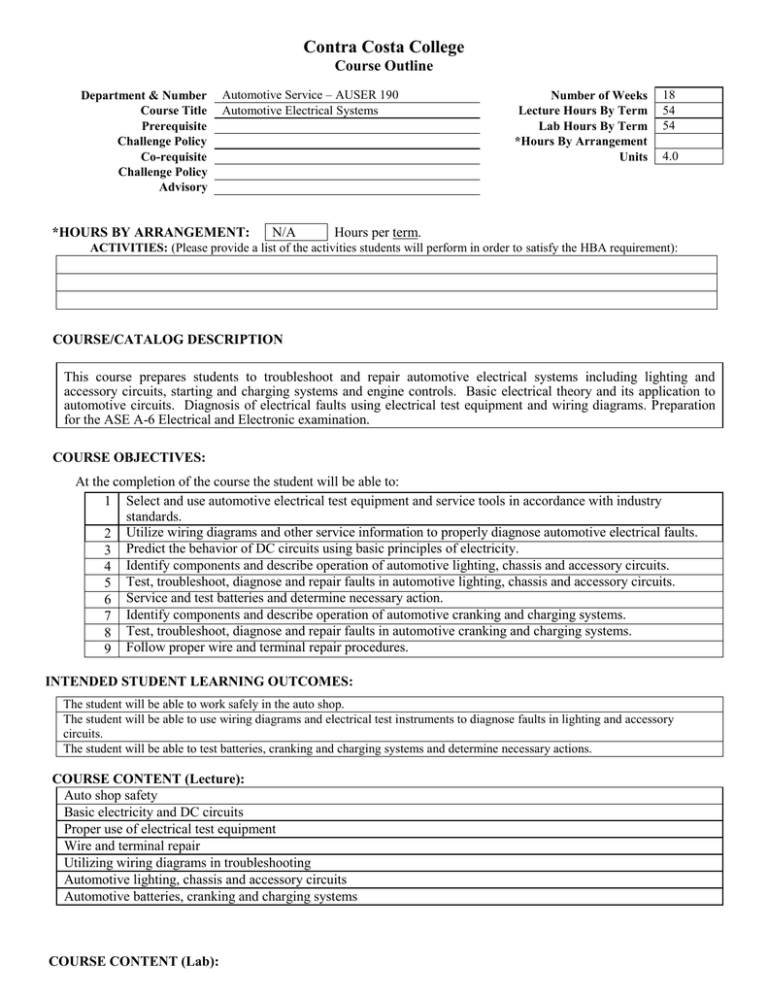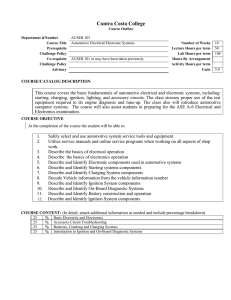
Contra Costa College
Course Outline
Department & Number
Course Title
Prerequisite
Challenge Policy
Co-requisite
Challenge Policy
Advisory
Automotive Service – AUSER 190
Automotive Electrical Systems
*HOURS BY ARRANGEMENT:
N/A
Number of Weeks
Lecture Hours By Term
Lab Hours By Term
*Hours By Arrangement
Units
18
54
54
4.0
Hours per term.
ACTIVITIES: (Please provide a list of the activities students will perform in order to satisfy the HBA requirement):
COURSE/CATALOG DESCRIPTION
This course prepares students to troubleshoot and repair automotive electrical systems including lighting and
accessory circuits, starting and charging systems and engine controls. Basic electrical theory and its application to
automotive circuits. Diagnosis of electrical faults using electrical test equipment and wiring diagrams. Preparation
for the ASE A-6 Electrical and Electronic examination.
COURSE OBJECTIVES:
At the completion of the course the student will be able to:
1 Select and use automotive electrical test equipment and service tools in accordance with industry
standards.
2 Utilize wiring diagrams and other service information to properly diagnose automotive electrical faults.
3 Predict the behavior of DC circuits using basic principles of electricity.
4 Identify components and describe operation of automotive lighting, chassis and accessory circuits.
5 Test, troubleshoot, diagnose and repair faults in automotive lighting, chassis and accessory circuits.
6 Service and test batteries and determine necessary action.
7 Identify components and describe operation of automotive cranking and charging systems.
8 Test, troubleshoot, diagnose and repair faults in automotive cranking and charging systems.
9 Follow proper wire and terminal repair procedures.
INTENDED STUDENT LEARNING OUTCOMES:
The student will be able to work safely in the auto shop.
The student will be able to use wiring diagrams and electrical test instruments to diagnose faults in lighting and accessory
circuits.
The student will be able to test batteries, cranking and charging systems and determine necessary actions.
COURSE CONTENT (Lecture):
Auto shop safety
Basic electricity and DC circuits
Proper use of electrical test equipment
Wire and terminal repair
Utilizing wiring diagrams in troubleshooting
Automotive lighting, chassis and accessory circuits
Automotive batteries, cranking and charging systems
COURSE CONTENT (Lab):
Auto shop safety
Basic electricity and DC circuits
Proper use of electrical test equipment
Wire and terminal repair
Utilizing wiring diagrams in troubleshooting
Automotive lighting, chassis and accessory circuits
Automotive batteries, cranking and charging systems
METHODS OF INSTRUCTION:
Shop Work
Lecture
Discussion
Demonstrations
On-line training – Safety and Pollution training
INSTRUCTIONAL MATERIALS:
NOTE: To be UC/CSU transferable, the text must be dated within the last 7 years OR a statement of justification for a text beyond the
last 7 years must be included.
Textbook Title:
Author:
Publisher:
Edition/Date:
Textbook Reading Level:
Justification Statement:
Automotive Technology: Principles, Diagnosis, and Service
James D. Halderman
Pearson Prentice Hall
Fourth Edition / 2012
Fresch-Kincaid Grade Level 10.2
(For textbook beyond 7 years)
Lab Manual Title (if applicable):
Author:
Publisher:
Edition/Date:
OUTSIDE OF CLASS WEEKLY ASSIGNMENTS:
Title 5, section 55002.5 establishes that a range of 48 -54hours of lecture, study, or lab work is required for one unit of credit.
For each hour of lecture, students should be required to spend an additional two hours of study outside of class to earn one
unit of credit.
State mandates that sample assignments must be included on the Course Outline of Record.
Outside of Class Weekly Assignments
Hours per week
Weekly Reading Assignments (Include detailed assignment below, if applicable)
4
Read chapter assignments and answer homework questions from reading material
Weekly Writing Assignments (Include detailed assignment below, if applicable)
Weekly Math Problems (Include detailed assignment below, if applicable)
Lab or Software Application Assignments (Include detailed assignment below, if applicable)
Take on-line Safety & Pollution modules and exams (www.sp2.org)
Other Performance Assignments (Include detailed assignment below, if applicable)
2
STUDENT EVALUATION: (Show percentage breakdown for evaluation instruments)
Course must require use of critical thinking, college-level concepts & college-level learning skills.
For degree credit, course requires essay writing unless that requirement would be inappropriate to the course objectives. If writing
is inappropriate, there must be a requirement of problem-solving or skills demonstration.
50
50
%
Essay (If essay is not included in assessment, explain below.)
%
%
%
Computation or Non-computational Problem Solving Skills
Skills Demonstration
Objective Examinations
Other (describe)
%
%
%
Shop Work, Participation and Professionalism
Tests and Quizzes, Classroom Work and Homework
GRADING POLICY: (Choose LG, P/NP, or SC)
Pass / No Pass
X Letter Grade
90% - 100% = A
80% - 89% = B
70% - 79% = C
60% - 69% = D
Below 60% = F
70% and above = Pass
Below 70% = No Pass
Prepared by: Lucile Beatty
Date: 2/14/14
Revised form 01/14
Student Choice
90% - 100% = A
80% - 89% = B
70% - 79% = C
60% - 69% = D
Below 60% = F
or
70% and above = Pass
Below 70% = No Pass

